AFFILIATE MARKETING
7 Best Mailgun Alternatives to Boost Your Email Marketing Success in 2023
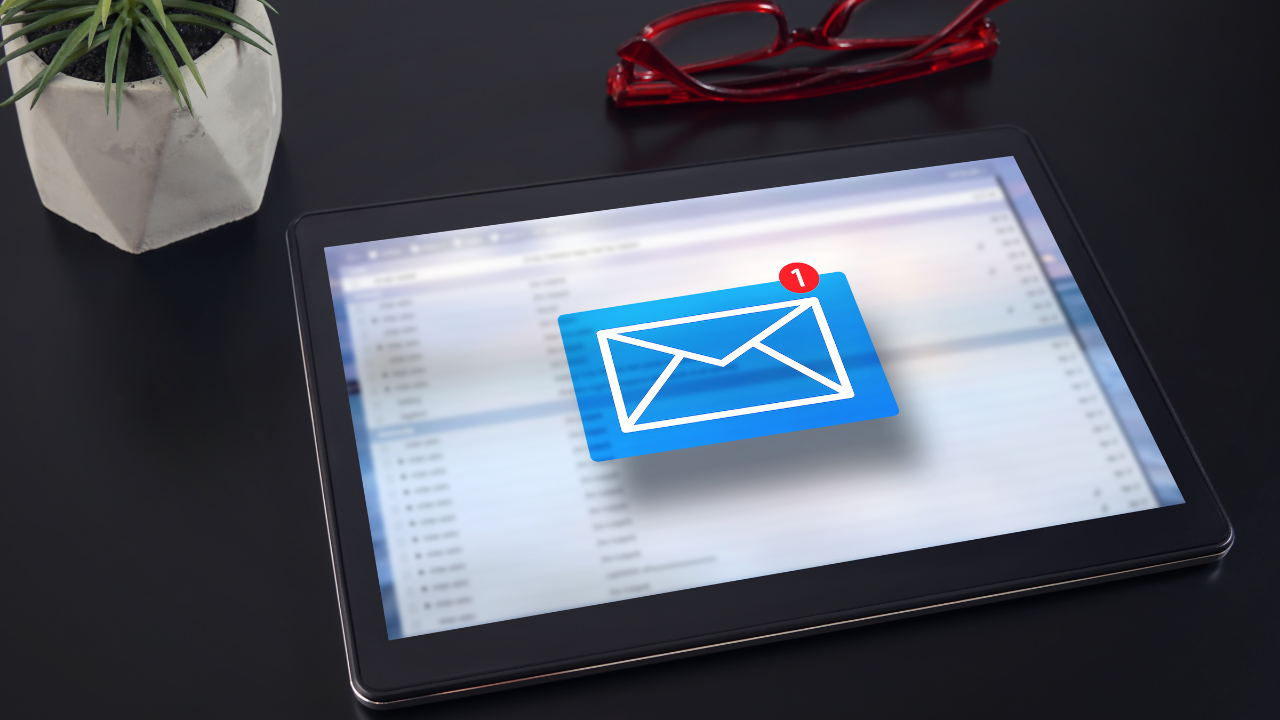
Are you an entrepreneur looking for a reliable email delivery solution? Tired of dealing with the hassles and limitations of Mailgun? We’ve compiled a comprehensive list of the seven best Mailgun alternatives to revolutionize your email marketing efforts.
From robust analytics to automation capabilities, these solutions offer powerful features that can take your business communication to the next level. So read on and find the perfect fit for you!
7 Great Mailgun Alternatives for Your Business
1. Sendinblue
Sendinblue is our top pick among Mailgun alternatives and is a perfect marketing solution for any SMB or enterprise-level business. You can send transactional emails and SMS to the desired recipient and track their effectiveness. The Detailed Analytics reports will help you fix any potential problems in email delivery or click performance.
You can use this all-in-one tool to create:
- Email marketing campaigns – design emails with the drag-and-drop editor or ready-made templates to send user-friendly emails
- Marketing automation – send responsive emails that are triggered once a condition in the workflow is fulfilled
- SMS marketing – communicate with customers on a more personal level
- Push notifications – send reminders for abandoned carts
Pricing
Sendinblue provides users with four plans to kickstart their business. The platform charges based on emails sent rather than on the size of your contact list.
Additionally, with the free plan, you can send 300 emails/day, along with the added features of SMS and Whatsapp campaigns.
The business plan is the most popular amongst entrepreneurs. You can send 20,000 emails/day for $40 a month. You will also gain access to a number of bonus features, making it a perfect choice for marketing managers and professionals.
Pros
- User-friendly interface
- Forever-free plan
- Access services in more than 6 languages
Cons
- Lower free email sending limit compared to some of the other alternatives
2. Amazon SES
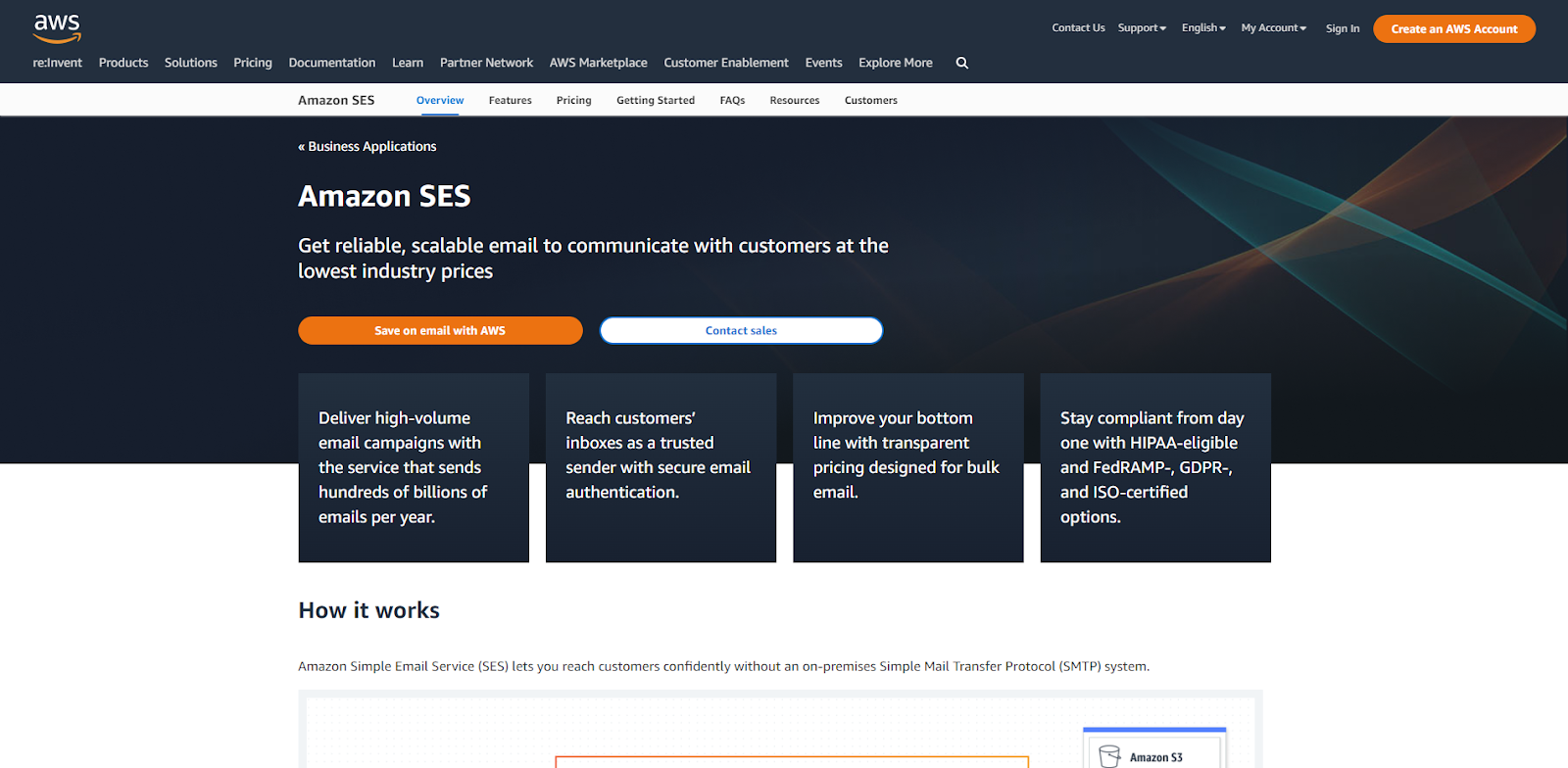
Amazon SES (Simple Email Service) is one of the cloud-based Mailgun alternatives used to send bulk marketing and transactional emails to customers. Small to large-scale businesses can use the platform to send emails through different methods. These include Amazon SES API, SMTP relay, and Amazon SES Console.
Amazon SES also provides support for owned, shared, or dedicated IP addresses to provide security and fast deliverability.
You can use the platform to send automated emails based on triggers and gain insights into their performance. Amazon SES is also known for its:
- Mailbox Stimulator – test how different scenarios will affect your application
- Email receiving – complete control over which emails to accept based on IP address and domain of the sender
- Reputation Dashboard – track issues of email performance such as bounce rate and feedback loops
Pricing
Amazon SES offers a pay-as-you-go scheme for sending emails. However, users hosting their applications on Amazon EC2 can send 62,000 emails a month for free.
You can also use the platform to receive up to 1000 emails for free and use pay-as-you-go to receive any additional emails.
Pros
- Increased sender security through multi-factor authentication
- Affordable rates for sending and receiving emails
- Generous forever free plan
Cons
- You’ll have to buy separate plans for inbound emails and outbound emails
3. MailerSend
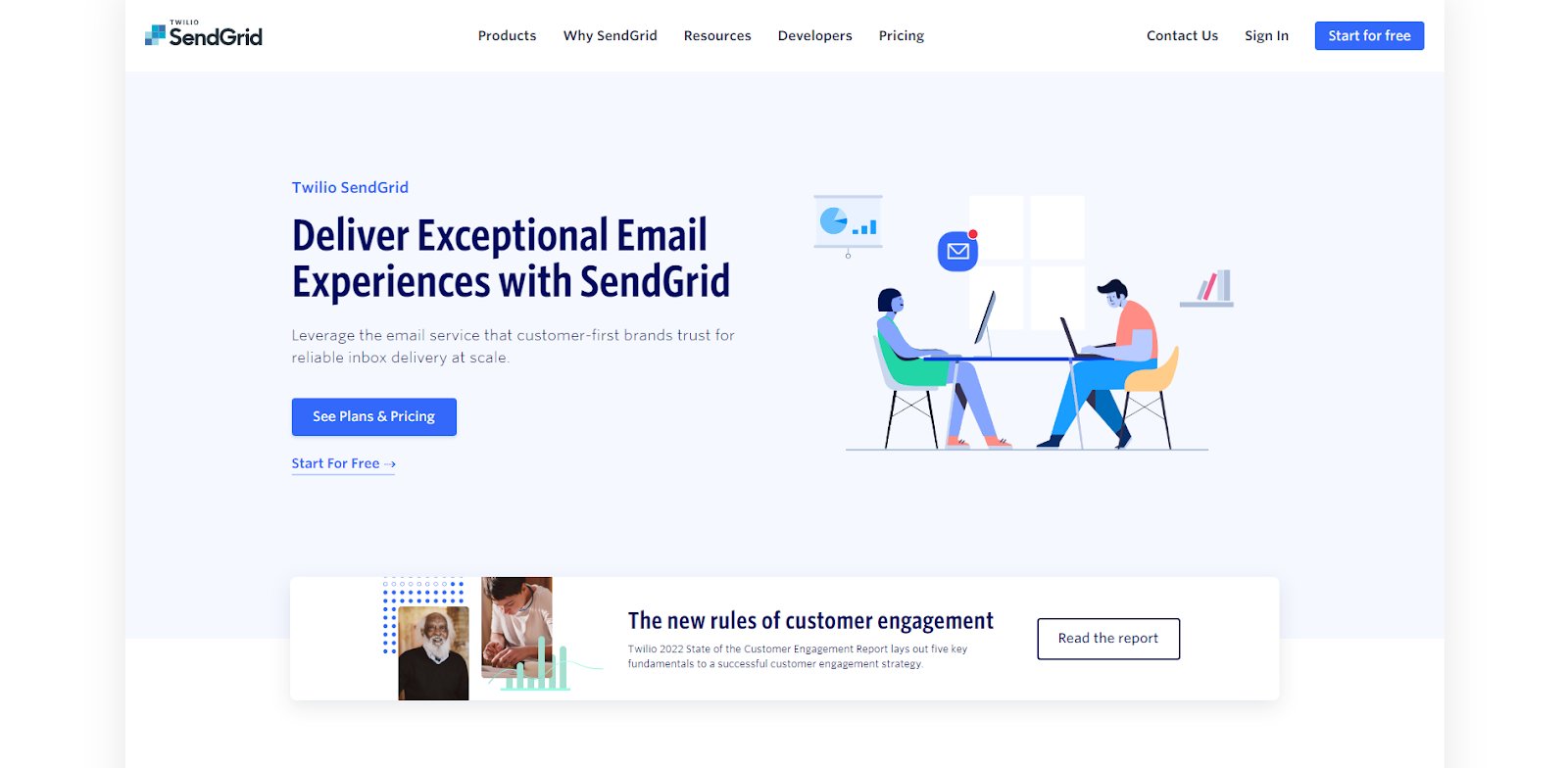
MailerSend is another alternative to Mailgun that provides a transactional email service along with a transactional SMS service.
You can use the platform to send and receive emails with SMTP relay and get hold of the following features:
- Multiple domains – manage multiple products and domains with just one MailerSend account
- Email verification – advanced verification process to ensure messages are received in the intended inbox and avoid landing in spam
- Dynamic email templates – send bulk emails that are tailored to suit different customers
- IP allowlist – make your account more secure by adding IP addresses to a whitelist
Pricing
MailerSend offers a forever free plan with 12000 emails/month. It is best suited for startups or SMBs to benefit from bulk emailing, a drag-and-drop builder, and analytics tools.
The paid plan includes a Premium plan and an Enterprise plan. The Enterprise plan is specifically designed for large enterprises and offers unlimited domains and templates along with 30-day data retention.
Pros
- Bulk email sending
- Effortlessly integrate sending transactional emails with your technology
- Efficient sender reputation management using SPF, DKIM, and DMARC security protocols
- Provides resources to get you started
Cons
- No SMS marketing service available in the free plan
4. Postmark

Postmark is an email delivery service platform that differentiates itself from other Mailgun alternatives with its email deliverability.
It uses a separate but similar infrastructure to send promotional and transactional emails. The latter is delivered through a secure and faster network.
Other features of Postmark include:
- Analytics tools – 45 days of data retention that ensures you don’t miss any detail
- Email templates – choose layouts for common transactional emails
- Webhooks – get notifications on important events such as bounces, clicks, or any spam complaints
Postmark offers a forever-free plan that includes 100 emails per month. However, more is needed for growing organizations.
The paid plans start with 10,000 emails at $15/month. Any additional emails sent in the month are charged with pay-as-you-go. You can also add dedicated IPs at $50 a month to any package.
Pros
- Complete email marketing software to send transactional and broadcasted messages
- Free expert advice
- Fast and reliable email delivery
- Email and application security
Cons
- No SMS support
- Marketing automation and segmentation features are not available
- Pricey for the number of emails allowed
5. SendGrid

SendGrid is a marketing and transactional email service provider that uses web API and SMTP relay to send emails. It is trusted by startups, enterprises, developers, and high-volume senders to increase customer engagement and experience.
Other than sending transactional emails, you’ll also get access to:
- Email marketing campaigns – send crafted automated messages to build meaningful relationships with customers
- Email testing – spam test and create flawless emails that look perfect in every inbox
- Deliverability insights – scalable email delivery measured using primary metrics and trends to improve the health of your email programs
- Email templates
Pricing
SendGrid allows users to choose between Email API plans and Marketing Campaign Plans. Both categories offer forever free plans, with the email API plan starting at 100 emails/day.
Additionally, The Marketing Campaign Plans offers a free plan where you can send up to 6000 emails/day along with segmentation, email automation, and design & code editors.
However, you need to upgrade to the Advanced Plan to get access to a dedicated IP address. It will provide you with faster site speed and a secure sender reputation.
Pros
- Forever free plan
- Free resources to initiate the correct email program
- The platform supports different programming languages
Cons
- You can not receive Email API plans and Marketing Campaigns Plans under one package
6. SocketLabs
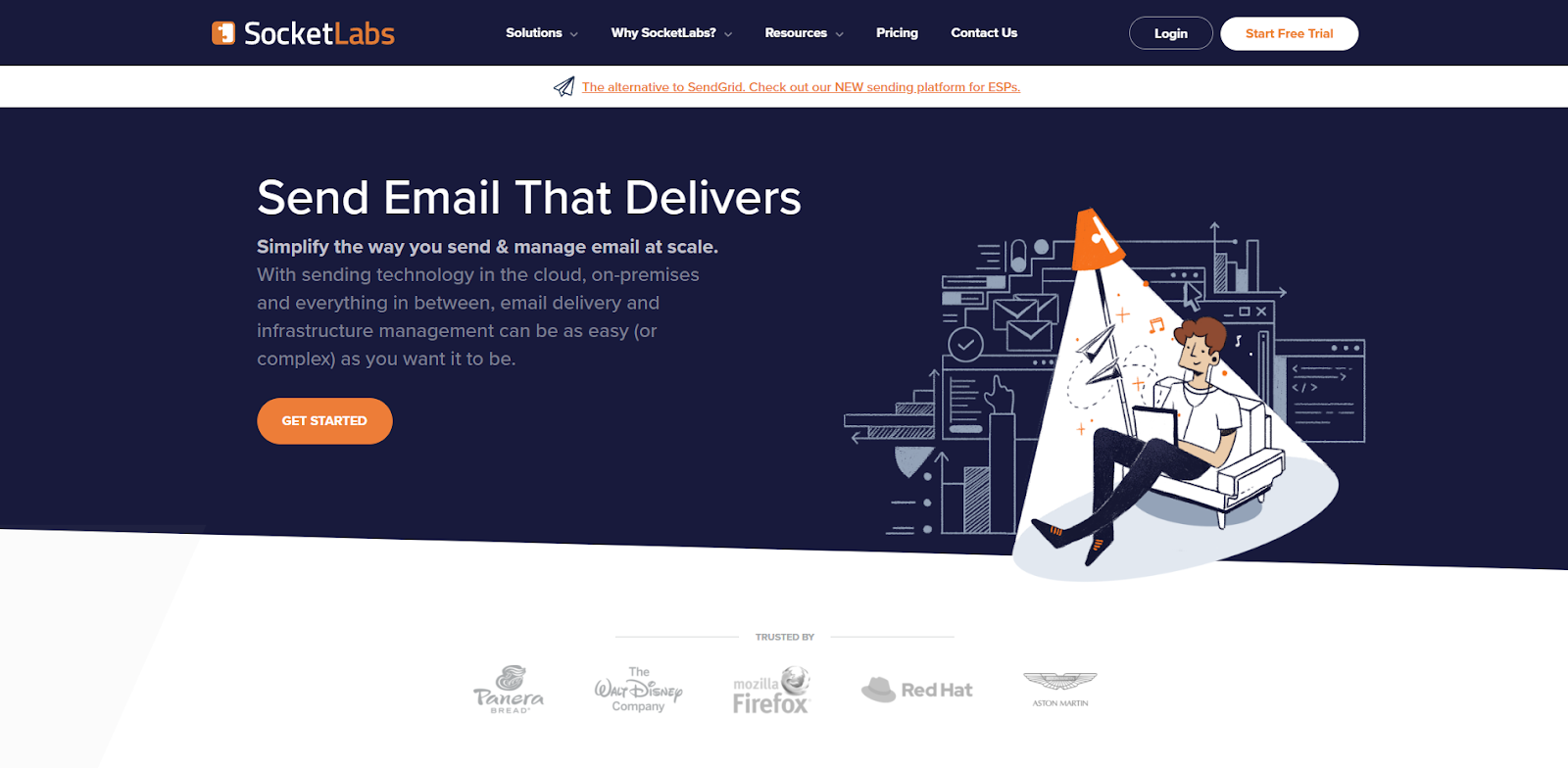
SocketLabs is an email delivery solution for IT pros, developers, and high-volume senders. It offers SMTP relay service and transactional email APIs. It’s one of the best Mailgun alternatives on the market because it offers many of the same features.
Users can trust the platform to deliver bulk emails that are fully verified and passed through strict anti-spam processes. With a tedious job cut out, the marketing teams can focus on using SocketLabs to create tailored solutions for priority accounts.
If you like SocketLabs for its ability to forward a high volume of emails, check out these best email forwarding services for even more options.
Pricing
SocketLabs offers a 30-day free trial for the Core plan. Then you can send 40,000 emails/month for $39.95.
The more expensive plans include the Pro Plan and the Concierge Plan. You can send 100,000 emails per month starting from $79.95.
You’ll also get access to “Insight History” and “Performance History” reports with all plans.
Pros
- Useful resources and code libraries to easily set up sending emails
- Integrate with any application
- Useful analytics tool to improve email performance
Cons
- No SMS marketing service
- No forever free plan
- Ongoing training and email performance review are not available for low-tier plans
7. SparkPost
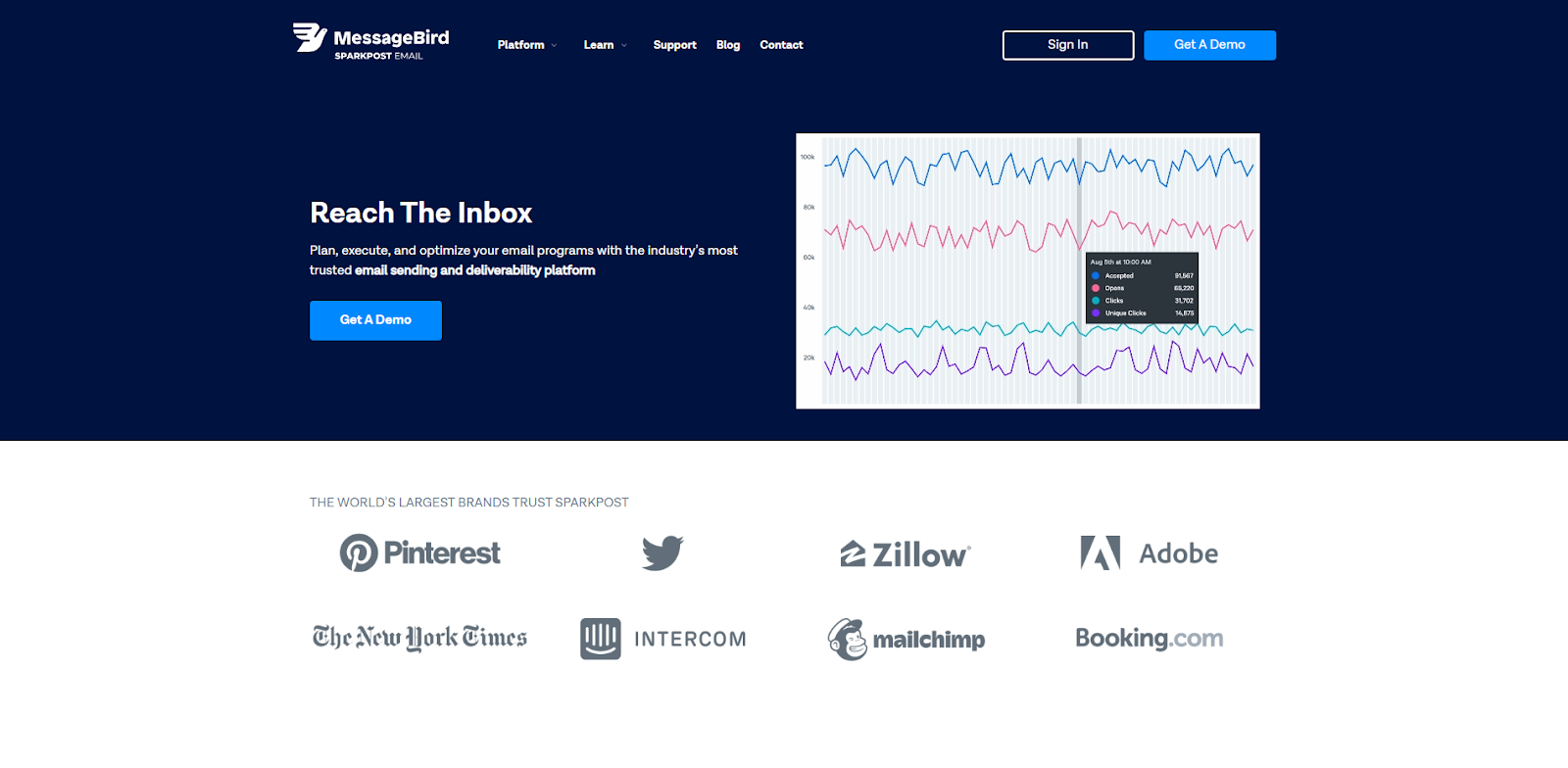
SparkPost is a reliable platform for brands to send and deliver emails. You can use advice from high-level industry experts to create email programs that engage and retain customers.
SparkPost is not just like any other Mailgun alternative. It goes beyond the basic deliverability of emails to provide an all-in-one marketing tool that increases customer engagement through:
- SparkPost signals – track email health and recipient behavior to improve email performance and reduce the risk of hitting spam traps
- Taxi for email – use segmentation and personalization to create powerful email campaigns
- Recipient validation – verify email addresses before you send them
- Inbox tracker – receive a higher return on email ROI by reaching more subscribers
Pricing
SparkPost has a free test account that limits the sending volume of emails but gives unrestricted access to API or SMTP relay.
Also, as a new sender, you can choose the Starter plan that offers 50,000 emails at $30 a month. This includes alerts to increase engagement and email health.
With a Premier plan, you can send 100,000 emails at $75/month and also get access to advanced templates and snippets, AB testing, prioritized support, and a dedicated IP address.
Pros
- Easily track how consumers are responding to competitors’ email campaigns
- Affordable plans for sending transactional emails
- Integrates with different apps and websites to fit user’s needs
Cons
- Limited volume for sending emails with free test accounts
Bottom Line: What’s The Best Mailgun Alternative For Your Business?
All in all, there are a host of excellent Mailgun substitutes that can completely transform your email delivery process.
Selecting the right alternative depends on your organization’s specific needs and requirements. So be sure to do some research before making a final decision. But in general, we believe that Sendinblue is a very excellent choice for most cases.
Hope this guide helps make it easier for you to find the best Mailgun alternatives for your entrepreneurial needs!


















You must be logged in to post a comment Login